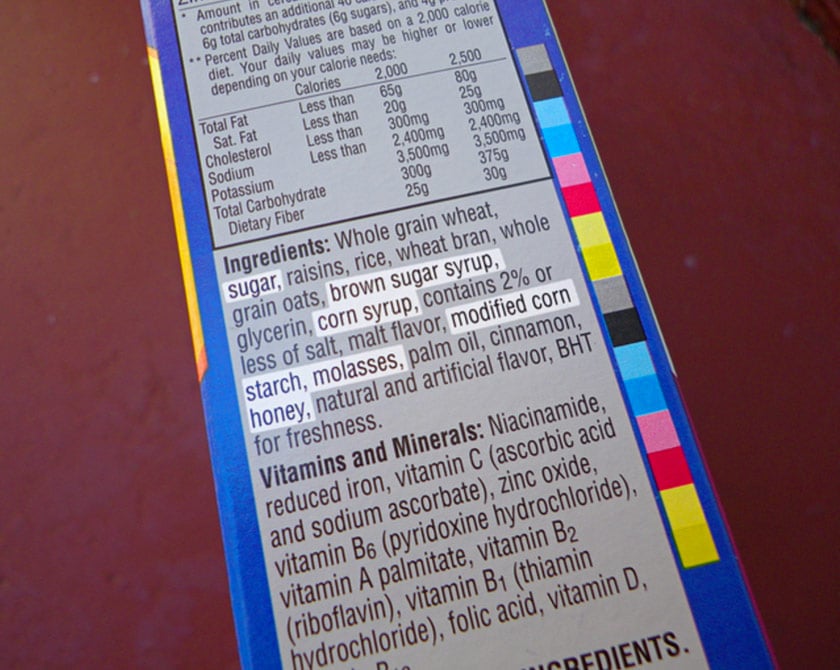Creating an Ingredients List on a Nutrition Label: A Guide to FDA-Compliance

Writing a FDA-compliant ingredient list for your food product doesn’t have to be complicated, especially if you use an online nutritional analysis software. Image source: Flickr user Daniel Oines
One of the challenges of being a food manufacturer is having to sift through seemingly endless FDA documents regarding food labeling requirements. Sometimes it can feel like you’ll never find the particular information you need no matter how much you scroll, click, and skim.
There’s little room for error when it comes to labeling your product, so it’s important to make sure every little detail complies with the FDA’s guidelines. This is especially true when it comes to ingredient lists, as there are many specifications, exceptions, and rules you need to know in order to complete the process correctly. What’s more, if done incorrectly, there could be consequences for improper labeling—something we all want to avoid.
Luckily, writing your ingredient list doesn’t necessarily mean spending hours pouring over FDA documents. When broken down into simple and actionable steps, you can create an ingredient list quickly, efficiently, and easily. Let’s walk through the process of making a FDA-compliant ingredient list for a nutrition label and discuss the specific formatting rules that apply.
Writing Your Ingredients List on a Nutrition Label in Three Simple Steps
An ingredient list on a food label, as defined by the FDA, is “the listing of each ingredient in descending order of predominance.” Put more simply, your ingredient list must contain every single ingredient present in your food product, in order of greatest to least. This means the ingredient that makes up the most of the product’s total weight will appear first, followed by the next, and so on. The end of the list should be the ingredient with the least weight.
That brings us to the first step in writing your ingredient list. Let’s use chocolate chip cookies as an example to illustrate the process:

Weigh out each of your ingredients and write them in the order of heaviest to lightest.
Flour, Sugar, Butter, Chocolate Chips, Vanilla, Baking Soda, Salt, Sodium Benzoate

If any ingredient has its own list of ingredients (sub-ingredients), list them parenthetically after the given item in the same order as above (greatest to least).
Flour, Sugar, Butter, Chocolate Chips (Cocoa, Cocoa Butter, Sugar, Soy Lecithin), Vanilla, Baking Soda, Salt, Sodium Benzoate

List any chemical preservatives by their common name and specify their function.
Flour, Sugar, Butter, Chocolate Chips (Cocoa, Cocoa Butter, Sugar, Soy Lecithin), Vanilla, Baking Soda, Salt, Sodium Benzoate to Preserve Freshness.
After completing these three steps, your ingredient list is essentially finished. There are, however, some special rules that may or may not apply to your list. Below are the most universal, but for a more detailed list, consult the FDA Food Labeling Document.
Notable exceptions and additional rules for ingredient lists include:
- Water must be listed as an ingredient.
- Always use an ingredient’s common name rather than its scientific one (i.e. salt, not sodium).
- Spices can be listed individually or as “spices” unless the product is a spice or spice blend.
- Added natural and artificial flavors can be listed as “natural flavors” or “artificial flavors” (unless one of the ingredients is one of the eight major allergens).
- Color additives exempt from certification (such as naturally derived ones) generally don’t need to be listed by name, but colors not exempt from certification do.
- Dairy products such as reconstituted skim milk, dry whole milk, or dried cream can be called “skim milk,” “milk,” and “cream,” respectively.
- Bacterial cultures must be declared along with the substrate (what the cultures were grown in) as “cultured milk.”
The Formatting and Font of an Ingredient List
Here are two things to keep in mind when formatting your ingredient list on your product package:

Your ingredient list must appear on the same panel of your package as the name and address of your company and your nutrition facts panel. Typically, the ingredient list appears under the nutrition facts panel, but it can also be placed above it.

Your ingredient list must use a font the consumer can easily locate and read. While a specific font size is not given, the guidelines are that the lower case “o” must measure at least 1/16 of an inch in height.
Of course, your ingredient list can be generated automatically for you if you use a FDA-compliant online nutrition analysis software with an ingredient labels template. With software such as LabelCalc, you can edit or tweak your ingredient list if you prefer different wording or if your ingredient has a special rule or exception. In most cases, however, it will appear as it should on your package. In addition to making an ingredient list, any allergens present in your product will also appear in an allergen statement at the end of your ingredient list.
While FDA food labeling regulations can seem overwhelming and confusing, using online nutrition analysis software can save you a lot of time you’d otherwise spend scrolling through lengthy government documents. LabelCalc allows you to generate FDA-compliant nutrition facts panels and ingredient labels in minutes without any prior food labeling knowledge. And if any labeling questions do arise, our nutrition label expert consultants are happy to help. This way, you can ensure that all aspects of your nutrition label are FDA-compliant without spending hours becoming the expert yourself.
Download our free Recipe Entry & Nutrition
Labeling Guide today!
Watch A Demo
Simply search from our extensive ingredient library of over 18,000 items, to find the ingredients in your recipe (e.g. 1 cup of flour, 2 oz of butter), and LabelCalc will automatically calculate the nutrition analysis, your product-specific serving size, servings per container, and generate an ingredient statement with any relevant allergy warnings. Then you can print and download your FDA approved Nutrition Facts Labels right from your account!
